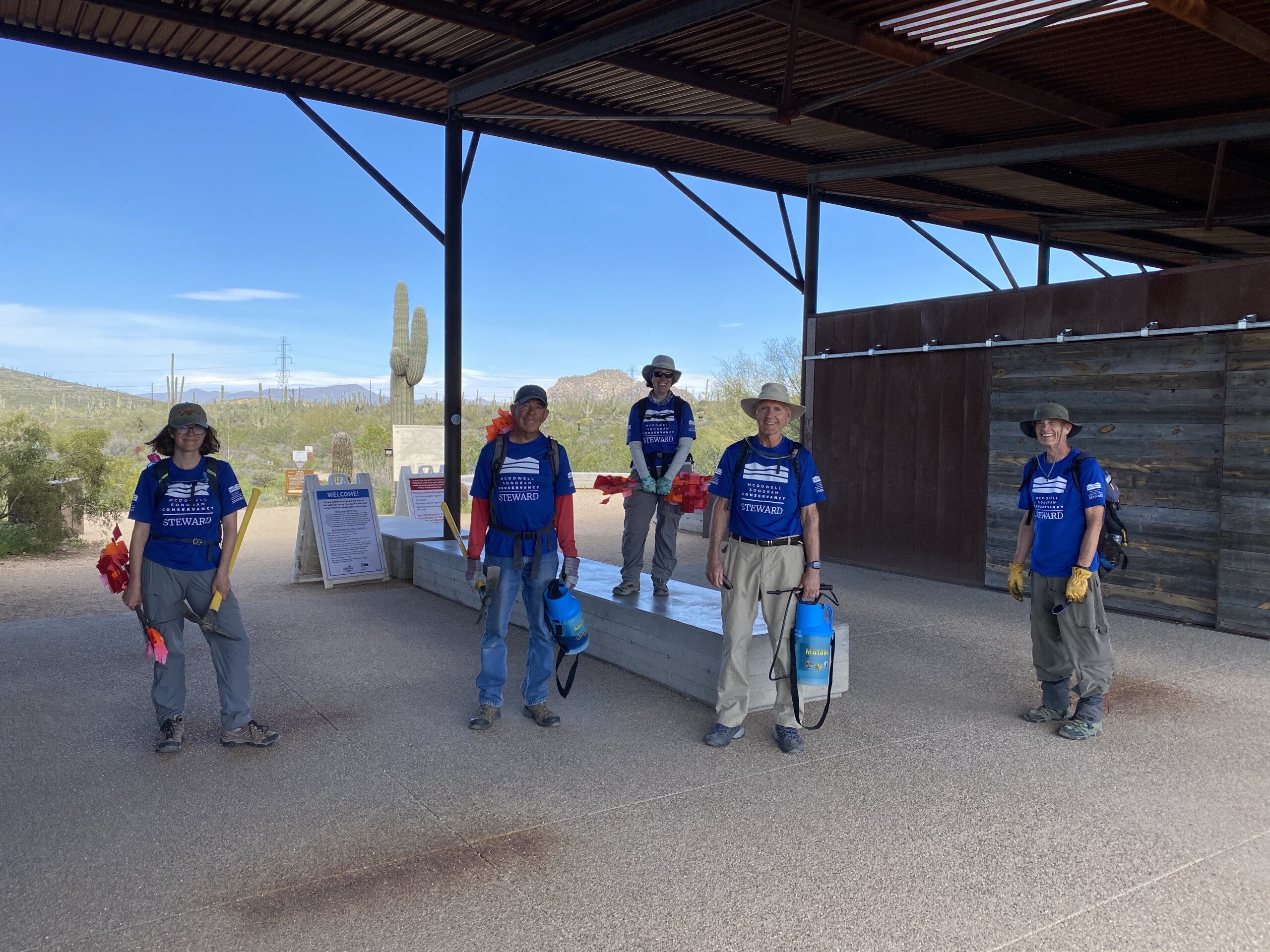By Tiffany Sprague, Parsons Field Institute Manager, and Mary Fastiggi, Parsons Field Institute Lead
Wow, what a year it has been. As with much of life, the pandemic has made McDowell Sonoran Conservancy’s science work even more challenging – from planning to implementation to analysis to reporting. But through creativity and tenacity, we managed to accomplish more than we dreamed was possible.
One of our greatest challenges was the inability to engage more people as citizen scientists. In a “normal” year, more than 100 people participate in our projects, volunteering hundreds of hours to survey for wildlife, remove non-native plants, restore degraded lands, process and analyze data, etc. Citizen science is a two-way street, with benefits for both scientists and for the volunteers. Scientists get the obvious benefit of free labor, as well as new ideas from a diverse group of people and opportunities to educate others in why their work is important. The volunteers benefit from learning new things, discovering new talents, and becoming more aware of their world. Likewise, the planet also benefits from the work being done as well as through new ambassadors for its health.
However, in this very abnormal year, we had to cut field teams down to the bare minimum to maintain safety. Because we could not conduct hands-on training, we generally had to rely on experienced individuals, which meant we could not introduce new people to the work we do. With our office being closed, much of the administrative side of our work stayed with staff rather than being used as an additional engagement opportunity for volunteers. All of this made completing our work more difficult and eliminated those many benefits of engaging people as citizen scientists.
Despite these challenges, we had a very successful year and managed to get nearly all of our projects done! We even started some new projects and expanded a few existing ones. Below is a sampling of some of our accomplishments. It’s been a busy, crazy time!
Every year, we conduct dozens of plant and animal surveys – from bats to birds to butterflies and beyond. This year, we successfully completed every one of those surveys, as well as deployed and maintained 34 wildlife cameras. We even detected six new species for McDowell Sonoran Preserve: Hammond’s flycatcher, blue grosbeak, savannah sparrow, desertbells, prickly goldenfleece, and Moroccan toadflax. The last two are non-natives, which we plan to keep an eye on to ensure they don’t spread and need to be mitigated.
Speaking of non-native plant work, we successfully removed non-native plants from dozens of acres in the Preserve. These efforts help reduce the risk of catastrophic wildfire (of which we saw too many in the state this year) and support native plants and animals. We also continued researching the most cost-effective treatments for removing non-natives, which will help make future work more efficient in the Preserve and beyond. Six of our stewards became certified to control non-natives using herbicides. On top of all of that, we helped establish the Invasive Species Working Group, a regional effort through the Central Arizona Conservation Alliance to direct non-native plant mitigation strategy in the greater Phoenix area. We also remained very active in the Desert Defenders program, which uses partnerships and community science to help control non-native species.
Our ecological restoration efforts ramped up this year, even as some projects wound down. We completed field work and are now preparing a manuscript summarizing the results of a multi-year project to determine effective trail restoration practices. We joined forces with the U.S. Geological Survey and other collaborators to help assess effective restoration techniques across all North American deserts. Our soil crust projects made significant progress, and, together with our partner at NAU, we became the first to successfully reintroduce mature soil crusts into the Sonoran Desert. As icing on this restoration cake, our manuscript about efficacy of common treatments was published in The American Midland Naturalist.
In addition to this work in the Preserve and broader region, we also started to assess the extinction risk of the nearly 4,000 native plant species that call the Sonoran Desert home. Coordinated through the International Union for the Conservation of Nature (IUCN), this international effort will help protect native plants into the future.
Above and beyond these projects, we continued our efforts to inform and engage the broader community, including through participation in conferences (most virtual), several presentations, workshops, and more. We continually seek to spread the word about the importance of the Preserve, the work we do, and how people can help – either through the Conservancy or in their personal and professional lives.
All said, it’s been a frustrating but also impressive year, and we are thrilled at how much we accomplished. None of this work would have been possible without the tireless dedication of stewards, staff, and partners. Looking back, we are filled with gratitude and amazement. Looking forward, we are excited to see what the new year has to offer.
Note: You can learn more about these and other projects through the following links:
- Project overview and 2019–2020 season review
- Non-native plant project overview (presentation to Preserve Commission)
- Long-term monitoring project overview (presentation to Preserve Commission)
- Habitat connectivity project overview (presentation to Preserve Commission)
- Spring successes
- Degraded lands mapping overview
- IUCN project overview
- Non-native plant work overview
- Amphibian project overview
- HOA coordination project


